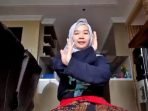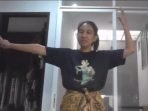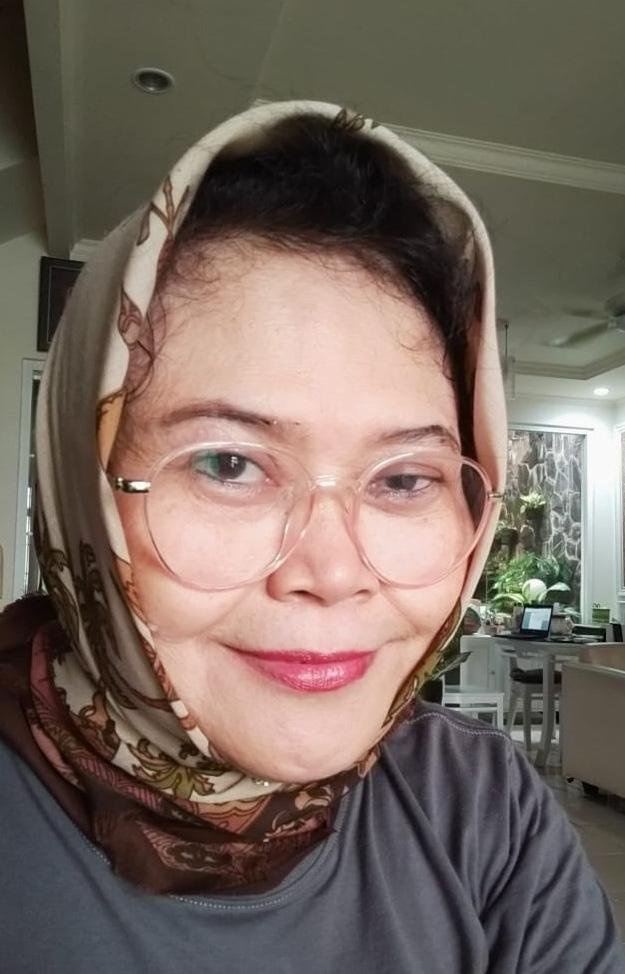By Retno Intani
Media Practitioner & Lecturer
“One two turn .. three four five six .. turn right … diagonal right back and forth left, .. megal megol .. move back right, lift right forward left then walk …. ”
That is the voice of Mbak Shinta Binol to direct the dancing movement, at the end of 2020 to participants who happily practice virtually dance exercise at their respective homes via zoom. There were 20 participants enthusiastically following the movements Betawi Lenggang Nyai dance directed by Mbak Shinta.This is a Betawi dance. Usually the dance that is performed is Javanese dance.
After two or three times the dance movement is repeated step by step without music, then full practice with its music.

Each participant looks happy even more this exercise is done at the day before the New Year 2021. There is enthusiasm among the participants to take part in the virtual exercise this time considering that the long holiday at the end of the year cannot be freely traveled due to the pandemic.
The situation at the end of 2020 left a reflection on how social human interactions are ruffled by virus to avoid the spread of the Covid19. Christmas which usually is celebrated by solemn praying with other congregants in churches, are mostly done virtually, festive music and fireworks parties with attendees are also done virtually.
Virtual activities eventually became a trend and it was also done by the KAGAMA Beksan Jabodetabek, dance-art lovers community.
In general, dance exercises are practiced in a large room so that the dancers can move freely, but the dancing exercise by Kagama Beksan Jabodetabek is done virtually in their respective homes, participants take advantage of the corner of their own houses that allows for dancing.
According to mbak Lurah, the nickname of Belinda Arunawati Margono, the coordinator of the Jabodetabek Kagama Beksan, the virtual training is held due to the pandemic, which is face-to-face training is not allowed in considering that participants are on average 80 people to attend. Of course this will be a crowd. She has been organized in response to the pandemic.

The dance practice is virtually scheduled via zoom once a week and then complemented by various tutorials uploaded on Youtube Kagama Beksan to encourage participants practicing independently. Is this intensive enough?
Basically, dancing practice is more effective when it is done face-to-face so that gathered movements can be immediately harmonized.
According to Mas Guru Widi and Mbak Lurah Belinda, the Javanese dance movement has the same function as yoga. Dancing is like relaxing and trains the human senses because dancing is about ‘wiraga’ (body), ‘wiratama'(rhythm) and ‘wirasa’ (feeling). There is a balance between body movements that follow the rhythm and use the feeling so that flexibility is needed.
Virtually, issues of limited space, lack of “wirasa” or feel and bandwidth become constraints. In addition, the dance teacher or instructor cannot immediately correct and the small screen display makes it difficult to capture the details of the dance.

So, seeing the obstacle, Mbak Lurah temporarily stopped the Yojan style (Yogya dance style) because of the difficulty in showing the details of the dance and the hassle of making corrections online.
KAGAMA Beksan Jabodetabek prioritizes the basic Javanese dance style Yogya (Yojan) and it happens that some members already have a strong basis for it.
In order to continue to be creative and not to stop with existing limitations, the Jabodetabek Kagama Beksan community during this pandemic developed the ability to complement dancing, for example, the practice of using cosmetics for makeup independently, dressed in dance, sing a Macapat all through virtual.
During this pandemic Beksan NIR Corona for man and woman dancer (kakung putri) and beksan Menak dances specifically for flash mob have been taught. Both dances are pure Yojan and use the basic tutorial from Kraton Yogyakarta. The third dance learned during pandemic is Betawi Lenggang Nyai dance.
The pandemic has not stopped the creativities of the Jabodetabek Kagama Beksan community. In addition to virtual group practice, tutorials for independent practice are prepared.
This community was born in July 2019 and is a branch of a large community called Kagama Beksan Indonesia under the management of the Gajah Mada Alumni Family (Kagama). Until now, there are 15 branches in cities spread across Indonesia and the operations of the cities of Jakarta, Bogor, Depok, Tangerang and Bekasi implemented through the KAGAMA Beksan Jabodetabek community.
Why is there KAGAMA Beksan Indonesia? Apparently it started when the flash video of Kawedanan Hageng Punakawan (KHP) Kridhomardowo Kraton Yogyakarta in Malioboro went viral. The video depicts millennials dancing beksan Wanaran nicely on the streets of Malioboro and is able to arouse Kagama’s awareness to preserve Indonesian culture. The idea was come up to establish KAGAMA Beksan Indonesia which turned out to be accepted by alumni spread all over Indonesia.
As for Beksan Jabodetabek, one and a half years of existence has already performed on-stage 8 times, flashmob 6 times and collaborated performances with dance studios in Jakarta twice. Of most interest were the flashmob. Pretty active, indeed.

Prior to this pandemic, routine exercise was held once a week but the exercise places changed, they are still mutually replaced since have no fixed place yet. The main trainer is mas Guru Hendricus Widi, an alumna of the UGM Civil Engineering Faculty. Even they don’t have a permanent training ground, it doesn’t prevent them from continuing to do activities.
This is in line with the appeal of the Chairman of Kagama 2019-2024, Ganjar Pranowo when giving a speech virtually at the inauguration of the board for the 2020-2021 period of the Netherlands KAGAMA Foreign Branch through Webex platform on Saturday (11/14/2020). He stated that this pandemic did not hinder Kagama’s activities. In fact, there are more and more innovative activities to contribute and to solving problems related to the COVID-19 pandemic.
Then,are the participants only from UGM alumni? Apparently not.
Art and culture are universal, therefore this community opens up to anyone who wants to learn to dance. However, there are requirements that must be met, namely a desire to maintain the nation’s culture and willingness to learn and develop themselves in arts and culture.
“Those who like to dance or who want to learn how to dance can join as long as they accept to appear with the name of Kagama, you know,” said mbak Lurah, Belinda A. Margono.
Yes. The name Kagama is indeed attached to every activity of the Jabodetabek Beksan because this community is under the KAGAMA Central Management and has official management.
Kagama Beksan is one of the Gadjah Mada Alumni Family activities which have the aim of inviting the public to preserve the noble culture of the Indonesian nation, especially its traditional dances.
Kagama Beksan is indeed very close to dance, especially traditional Javanese dance because the word Beksan itself comes from the word bekso / mbegso or hambegso which means dance. Even so, according to the aim of preserving the noble culture of the Indonesian nation through dance, Kagama Beksan also danced traditional Indonesian dances besides Javanese, for example during this pandemic the Betawi dance, Lenggang Nyai was taught.
As for KAGAMA itself, it is an organization of alumni of Gadjah Mada University (UGM). The idea to form a united UGM alumni organization arose in 1956. In commemoration of the UGM Anniversary in 1958, Ir. Suwarno (late) was urged by the UGM Student Council Anniversary Committee to take the first initiative to hold the first UGM alumni deliberations from various cities on 18 December 1958 in Yogyakarta. From this deliberation, the organization “Gadjah Mada University Alumni Family”, abbreviated as KAGAMA, was born.
KAGAMA is a family organization, not a political organization. The tagline popularized by Ganjar Pranowo, the Chairman of Kagama 2019-2024 is guyub, rukun lan migunani (friendly, peaceful and useful).
KAGAMA stands outside UGM, but maintains a close relationship with UGM. Until now, according to Lies, Head of Sub-Directorate for Alumni Relations, KAGAMA has around 341,000 alumni members spread out at home and abroad.
Referring to La Ode Untung’s record from the officer of KAGAMA Central Executive Secretariat, it is mentioned that organizationally there are 7 KAGAMA branches abroad, namely in the Netherlands, Saudi Arabia, Germany, Malaysia, Korea, Qatar, and Japan. Lies added that the KAGAMA community in Washington DC and Canberra is actively working. In the near future, the China branch of KAGAMA will be inaugurated. (RI)







